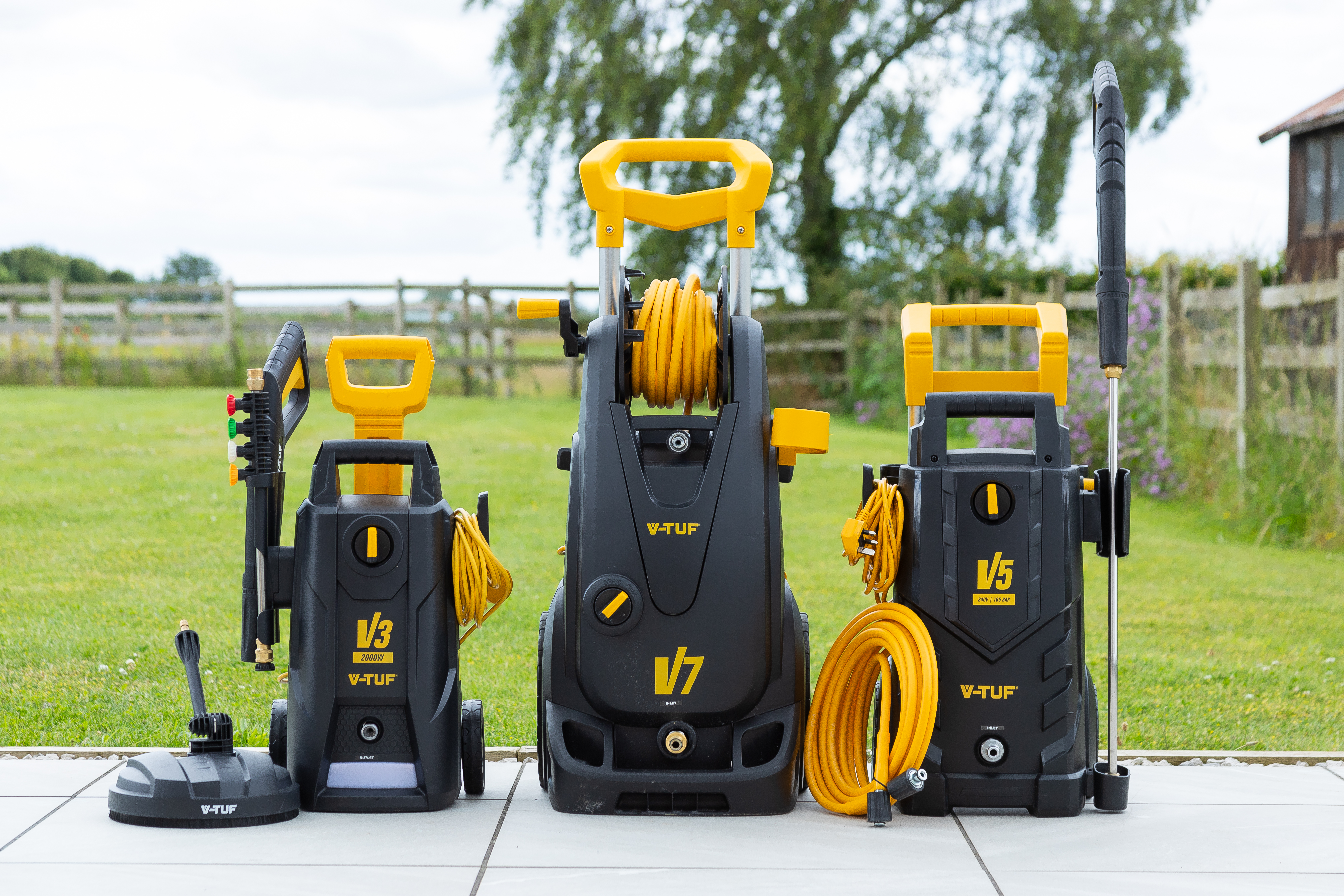How to Clean Your Patio with a Pressure Washer
Posted on: 29/10/2024, 16:10

Whether it’s your first time using a pressure washer to clean your patio or you are a seasoned exterior cleaner, this ultimate guide to pressure washing a patio will walk you through the process step-by-step, address frequently asked questions, and share our top tips for sparkling results!
Why should you pressure wash your patio?
When spring rolls around, we tend to find our patios have accumulated a less-than-attractive layer of grime. Patio ‘grime’ can be composed of dirt, grease, pollutants, algae, lichen, moss and mulched leaves, that have accumulated over the damp winter months. Aside from this being unsightly, grime and algae build-up can cause patios to become dangerously slippy. While it can be easy to maintain a clean patio with regular sweeping and rinsing throughout the summer months, the easiest way to quickly rejuvenate a neglected post-winter patio is with a pressure washer. Pressure washing is not only a time-saving cleaning solution, but it is also highly effective in removing stubborn, hard-to-clean stains and black spots. A thorough pressure wash can bring even the grimiest of patios back to life, so you can enjoy a garden patio that looks as good as new! Not only is a well-maintained patio safer and more aesthetically pleasing, but it can also boost a property’s value and kerb appeal.
V-TUF’s Ultimate Guide: How To Pressure Wash A Patio Step-by-Step
Preparation: Equipment and materials for pressure washing a patio
- Step 1: Preparing a patio for pressure washing
- Step 2: Setting up your pressure washer
- Step 3: Pre-treatment and rinsing a patio
- Step 4: Deep cleaning a patio with a pressure washer
- Step 5: Patio preservation and protection
- Step 6: Future patio upkeep and maintenance
- V-TUF top tips for pressure washing a patio
- Frequently Asked Questions
Preparation: Equipment and materials for pressure washing a patio
Pressure washer: Choosing a suitable pressure washer for cleaning patios
There is a vast selection of pressure washers designed for a range of purposes. When choosing the most suitable pressure washer for your patio, several factors must be considered. One factor to consider is water pressure, measured in bars or PSI (pounds per square inch). Using a pressure washer that is too powerful can result in damage to your patio, but if it is too weak, you’ll have a hard time removing grime. A medium-strength pressure washer (110 - 130 bars) is suitable for cleaning light debris or for use on delicate patio tiles. However, a heavy-duty pressure washer (130 - 150 bars) is recommended for regular patio tiles, especially for removing stubborn black spots or thick grime build-up. Other factors to consider when choosing a pressure washer include storage, portability and usage.
A compact, lightweight domestic pressure washer such as the V3 240 V-TUF jet wash is ideal for homeowners with limited space. With a maximum pressure of 150 bars, the V3 240 V-TUF pressure washer is highly effective for any level of grime build-up on patios. The V3’s lightweight design allows for effortless movement and handling, making easy work of any patio, big or small!
For professional exterior cleaners, property developers, or those working with larger commercial patio spaces, a heavy-duty pressure washer, such as the V-TUF RAPID SSC All-Stainless Industrial Mobile Pressure Washer, is a superb option. The V-TUF Rapid sports a robust yet compact stainless-steel design, making it durable enough for heavy-duty use while still being compact enough for convenient transport and storage.
Pressure washer nozzles: Which pressure washer nozzle is best for cleaning a patio?
There are five universally colour-coded pressure washer nozzles: red (0°), yellow (15°), green (25°), white (40°) and black (60°). The V3 240 V-TUF pressure washer comes with the full range of universal pressure washer nozzles, as well as the V-TUF Professional Turbo Nozzle. A low-degree nozzle produces a highly condensed jet stream at high pressure. This is great for tackling difficult stains and spots, but the narrow jet can leave streaks on patios and can potentially cause damage. Conversely, a low-degree nozzle produces a wider jet stream, which gives larger, more even coverage. However, the decreased pressure can make it harder to tackle tough grime. Finally, a rotating turbo nozzle uses high-speed oscillations to increase both the pressure and coverage of the water spray.
To avoid streaks when cleaning a patio, we recommend starting with a green (25°) nozzle, and using the Turbo Nozzle for difficult-to-tackle thick or stubborn grime.
Pressure washer attachments: Which pressure washer attachments are needed for cleaning a patio?
It is possible to clean a patio with just the nozzle attachments above. However, there is a wide range of specialised pressure washer attachments that are extremely adept at tackling tough grime and will enhance the overall end results. In addition to the six nozzles, the V3 pressure washer also includes a V-TUF patio cleaner attachment with deep-clean jets. Patio cleaner attachments use rotating jets to distribute high-pressure sprays evenly across the patio surface. This removes loose debris and surface dirt while minimising damage to the patio slabs. Patio cleaner attachments are designed to be easy to manoeuvre while keeping debris and splashing to a minimum for a safer, more efficient, hassle-free, deep clean.
For heavier commercial use, we recommend the larger V-TUF Surface Cleaner, which is compatible with the V-TUF Rapid Industrial Mobile Pressure Washer. The V-TUF Surface Cleaner features a larger disc size supported by heavy-duty, easy-glide castor wheels. These design features allow the user to clean larger patio surface areas in much less time and are durable enough to withstand regular use.
Detergents: Do you need detergents to pressure wash a patio?
Using the right detergent for your pressure washer can help you tackle tough dirt, make cleaning your patio easier, and provide longer-lasting results. It’s essential to carefully consider which detergent you use; using the wrong detergent can damage patio tiles and pose a possible health risk to children and pets. V-TUF’s D-Green Garden Surface Cleaner has been formulated for safe and effective use on garden surfaces, including patios. This detergent is designed to gently remove moss and algae on contact, with no scrubbing required. Not only does it speed up the removal of algae and moss, but it can prevent regrowth for up to 6 months after treatment when used as a sealant. Doing a deep clean using D-Green Garden Surface Cleaner means in the following months, you only need to rinse your patio with a pressure washer to maintain it, saving you time in the long run.
If you are using a detergent, a foam cannon attachment can help evenly disperse it over a large surface area. The V3 240 V-TUF pressure washer comes with a foam cannon, the patio cleaner attachment, and a full range of nozzles, making it the ideal starter kit for cleaning patios.
Safety Equipment: What safety equipment should you use when pressure washing?
When using a pressure washer you should always wear goggles to protect your eyes from any flying debris. Pressure washers can be loud so we recommend wearing ear muffs whenever you are operating one. Lastly, wearing heavy-duty, waterproof gloves will protect your hands and help maintain grip.
Once you have your appropriate pressure washer, pressure washer nozzles, attachments, detergent and safety equipment, you can begin to prepare your patio.
Step 1: Preparing a patio for pressure washing
Clear your patio of obstructions
To get the best results from your pressure washer, you’ll want to start with a completely clear patio. Remove any furniture, belongings, and potted plants to make cleaning easier and to protect your belongings from debris, splashes, and detergent.
Remove any weeds
Weeds will quickly grow back if they are not removed along with their roots. They can also hide loose grout, stones and chipped tiles that pose a hazard when using the pressure washer. Properly remove any weeds around the patio before you begin pressure washing.
Check for and remove any remaining loose debris
Check for any loose or chipped pieces of patio slabs, as these can fly up during pressure washing. Before you start pressure washing, sweep up your patio, making sure you remove any debris, especially loose stones, gravel or chipped patio pieces.
Step 2: Setting up your pressure washer
Connect your high-pressure washer to the water supply
Most pressure washers, including the V-TUF pressure washers, can be connected to the main water supply with a hose. Some pressure washers, such as the V-TUF RAPID SSC All-Stainless Industrial Mobile Pressure Washer, include a Triplex Pump, which allows you to draw water from rain tanks or intermediate bulk containers. If your pressure washer does not include a pump for rain tanks, these can be purchased separately.
Once connected with the water supply, press down on the gun leaver to check that water is flowing freely through your pressure washer before turning on the power.
Switch on the power
Once you are confident the water supply is connected and flowing through your pressure washer, you can switch on the power. Be aware that there can be a powerful initial burst of water when first switching the power on. Ensure you have the nozzle pointed at the ground and away from you for this initial burst. Always keep the water jet directed away from the pressure washer itself and any electrical mains.
Step 3: Pre-treatment and rinsing a patio
Pre-treating the patio
If the patio has a thick build-up of biological matter such as lichen, algae or moss, pre-treating with detergent can help lift these. Always check the manufacturer's instructions regarding the use of the detergents with a pressure washer. With the V-TUF V3 Pressure Washer, detergent can be added to the built-in cleaning container, which will feed the detergent into the water as you use it. When applying detergent to your patio, you must use the low-pressure black nozzle. Alternatively, add the detergent to the foam cannon; this will allow for an even and controlled application that uses less detergent for the same coverage. Once you have applied the pre-treatment detergent, leave it to rest on the patio for 15 - 20 minutes.
Rinsing the patio
For the initial rinse, we recommend using the green nozzle; this will disperse the spray enough to prevent streaks or damage while being strong enough to rinse away detergent, loosened debris and remaining grime. Hold the lance at a 45° angle and rinse the patio, working back from the furthest point of the patio. For uniform results, use a sweeping motion to cover the surface evenly while maintaining a consistent distance between the nozzle and the patio. Remember, holding the nozzle too close or too far from the patio can result in streaks or uneven patchy results.
Step 4: Deep cleaning a patio with a pressure washer
Use the surface cleaner attachment to deep clean your patio
Using a patio or surface cleaner attachment to do a deep clean of your patio can significantly enhance your overall results. Patio cleaners are designed to evenly disperse the jets over a large surface while maintaining high pressure. They are easy to manoeuvre over large patio surfaces, providing a quick and efficient deep clean of your patio. Thoroughly rinsing and then deep cleaning your patio with the surface cleaner will ultimately reduce the number of tough spots requiring extra time and attention at the end. Patio cleaners are also designed to minimise splashing or projecting debris for a safer, hassle-free clean.
Address tough stains with the V-TUF Turbo Nozzle
The V-TUF Turbo Nozzle is ideal for removing any remaining tough stains by delivering a high-pressure rotating jet. The jet's oscillations prevent streaks that can occur when using narrow, high-pressure nozzles, such as the red or yellow nozzle. However, because the Turbo Nozzle delivers a high-pressure jet, it is important to avoid grout and chipped or damaged patio tiles, as the high-pressure jet stream can damage these weak points.
Rinse off the remaining debris with a wide-angle nozzle
After deep cleaning and tackling any tough stains, use the wide-angle black nozzle to rinse away any remaining debris and dirt lifted by the deep clean. It’s a good idea to allow your patio to dry before applying sealant or final treatments.
Step 5: Patio preservation and protection
Treat your patio with V-TUF D-Green
Now you have thoroughly pressure washed your patio and it’s pristine! However, you no doubt want to preserve your patio for as long as possible before another deep clean. Applying a layer of V-TUF D-Green using a wide-angle black nozzle, will help prevent the build-up of moss and algae for up to six months. Once applied, leave this final layer of detergent to fully dry on the patio. Once dried, the patio will be perfectly safe for children and pets.
Clean outdoor furniture
Any furniture, plant pots, or other belongings may be contaminated with grime from the patio. Clean any furniture before returning it to your patio, paying special attention to any dirt on the furniture's feet or the base of plant pots. This will prevent grime from being transferred back to your clean patio. If your furniture has significant grime build-up, the V3 240 V-TUF pressure washer is suitable for rinsing most garden furniture. Simply attach the wide-angle black nozzle for a quick and efficient way to clean your furniture.
Step 6: Future patio upkeep and maintenance
With proper maintenance, you won’t need to repeat deep cleaning of your patio more than once a year.
Regular de-weeding and sweeping
Keeping your patio clear of leaves, dirt, and weeds will help prevent decomposing biological matter from accumulating, which contributes to grime development. Regularly de-weed throughout the spring and summer months. Make an extra effort to keep on top of sweeping throughout the spring and autumn months, as this is when debris, such as fallen blossoms and leaves, can quickly build up.
Periodic Light Pressure Washes
Regularly rinsing the patio with a low (black) or mid-pressure (green) nozzle will help prevent early build-up of algae or moss. We recommend topping up the D-Green treatment on your patio twice a year. The best time to re-treat your patio is early autumn; this will prevent the build-up of grime, which can quickly accumulate during the autumn and winter months. We also recommend a second treatment in spring; this helps break down any grime that has accumulated over the winter months, preparing it for more frequent use throughout spring and summer.
Regular maintenance of your patio means fewer deep cleans! Plus, it won’t take nearly as much time or effort when it comes around to your annual deep clean.
V-TUF top tips for pressure washing a patio
Safety
- Always use goggles, ear muffs and gloves when operating a pressure washer.
- Always double-check your patio and remove any loose or large debris.
- Always point the jet away from yourself, the pressure washer equipment and electricals.
- Use both hands to hold the pressure washer whenever it is in operation.
- Be aware of a strong initial burst when first switching on the pressure washer.
Avoid
- Do not start with high-pressure, narrow-angle nozzles (Red, Yellow). These will create harsh, uneven streaks on patio tiles and can damage tiles and grout.
- Do not use a rotating turbo nozzle on grout or chipped patio tiles, as this can cause further damage.
- Be aware of your surroundings and avoid any materials (especially wood) or terrain that can be damaged by the pressure washer.
Best Practice
- Ensure you use a good quality pressure washer, well suited to your needs.
- Pre-treat your patio with detergent for an easier and deeper clean.
- Start with a mid-pressure nozzle (green) to avoid streaks, and only use a higher-power nozzle where it is needed for tough stains.
- Use a sweeping motion while maintaining a consistent distance between the nozzle and the patio for uniform results.
- Use a patio cleaner attachment for more even distribution and to reduce mess, splashes and flying debris.
- Tackle remaining stubborn stains and black spots using the Turbo Nozzle, remembering to avoid grout or chipped patio tiles.
- Post-treat the patio with detergent or sealant to get longer-lasting results.
- Wash furniture and plant pots before returning them to the patio to prevent contamination.
- Regularly sweep, de-weed and rinse the patio to avoid future grime build-up.
- Prevent algae and moss build-up by treating the patio with detergent twice a year.
Frequently Asked Questions
What should I put on a patio before a pressure wash?
If your patio has a particularly thick build-up of grime, dirt, algae, or moss, you can use a garden-safe detergent such as V-TUF D-Green to help lift it.
Do you need detergent to pressure wash a patio?
You can wash a patio without a detergent; a detergent will simply speed up the process and help tackle tough stains and thick grime build-up. Alternatively, power washers compatible with hot water are an effective chemical-free alternative to tackling tough grime and stains.
When should I pressure wash my patio?
You can pressure wash your patio any time of the year. If you are getting into the habit of doing a deep clean once a year, then spring is the best time to pressure wash your patio. Grime, algae, and moss can be particularly bad following the winter months due to damp weather and debris build-up, such as fallen leaves. Deep cleaning your patio in spring, followed by lighter pressure washes throughout the year, is the best way to maintain your patio.
Is it safe to pressure wash a patio?
It is safe to pressure wash most patio surfaces. We do not recommend using a power washer on block-paved patios as these are held in place with sand, which can be washed away by a power washer. For your safety, it is essential to check for chipped tiles and loose or broken grout. If not removed, these can fly up during pressure washing, so always adequately check and clear your patio before starting. Always ensure you wear the appropriate safety gear whenever you operate a pressure washer; this includes goggles, ear muffs and suitable gloves.
Do I need to seal a patio after pressure washing?
Applying a sealant will give longer-lasting results and slow down future build-up of grime, algae, and moss. Our V-TUFF D-Green solution doubles as a garden-safe detergent and can be used as a post-cleaning treatment for your patio.
V-TUF: Professional supplies of top-quality domestic and industrial pressure washers
Here at V-TUF, our knowledgeable, solutions-driven team has been focused on providing top-quality cleaning equipment for both industrial and domestic use for over 20 years. We are passionate about delivering cleaning equipment that is reliable and long-lasting while continuously working towards ensuring our products and manufacturing processes are as eco-friendly as possible. That is why our V-TUF cleaning products are manufactured here in the UK. We provide a wide range of top-quality domestic pressure washers, as well as an extensive range of pressure washers for industrial use. Whether domestic or industrial, we have designed all our pressure washers with efficiency, manoeuvrability and durability in mind. Don’t miss out and take a look at our range of pressure washers and accessories today.
Want to save 10% off your first order with V-TUF? Sign up to our mailing list for exclusive offers, latest news and trade tips, and get 10% off your first order!







